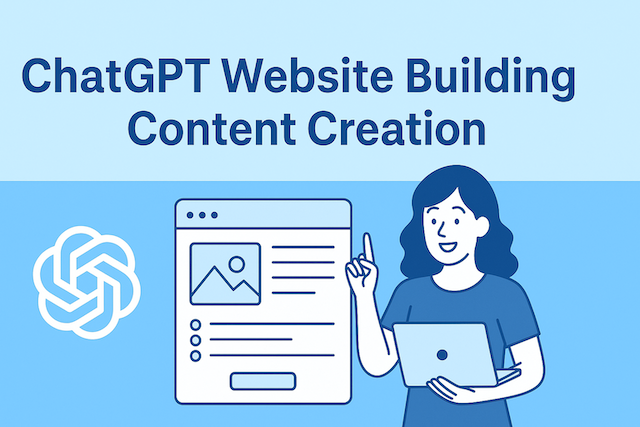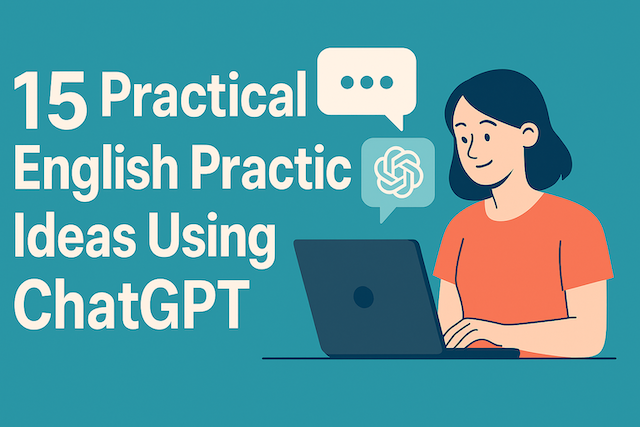Creating a Service Page in English with ChatGPT

Contents
- Creating a Service Page in English with ChatGPT
- Introduction
- Step 1: Define Your Service and Your Audience
- Step 2: Create the Structure of Your Page
- Step 3: Refine the Tone and Language
- Summary
- Step 4: Add Testimonials, Proof, or Case Studies
- Why This Step Matters
- Step 5: Add a Strong Call to Action (CTA)
- Summary
- Conclusion: You Just Built a Service Page in English—with ChatGPT by Your Side
Creating a Service Page in English with ChatGPT
No Native-Level English? No Problem.
Introduction
Writing a service page in English can feel overwhelming—especially if English isn’t your first language.
Maybe you’ve opened a blank document and stared at it for 20 minutes, wondering:
-
What should I say first?
-
How do I explain my services clearly?
-
Will it sound natural to international clients?
You’re not alone. Many freelancers, creators, and business owners feel the same way.
But here’s the good news: you don’t need to write it alone.
With the help of ChatGPT, you can create a well-structured, professional, and convincing service page in English—even if you don’t feel confident with writing.
Whether you’re a designer, language tutor, coach, developer, or marketing consultant, this guide will walk you through the exact steps to:
-
Describe your services in clear English
-
Highlight what makes you unique
-
Write with confidence, even if you’re not a native speaker
-
Turn visitors into potential clients
And the best part? All you need is your idea—and a few smart prompts.
Let’s get started by defining your service and who it’s for.
Step 1: Define Your Service and Your Audience
Before you ask ChatGPT to write your service page, you need to give it context.
Think of ChatGPT as your writing partner. It’s powerful—but it needs direction.
So the first step is simple: be clear about what you do and who you help.
Here are a few guiding questions to help you organize your thoughts:
-
What exactly are you offering?
(e.g. English coaching, logo design, social media strategy) -
Who is your target audience?
(e.g. Japanese professionals, startups, small business owners) -
What problems do your clients usually have?
(e.g. “They don’t know how to write emails in English,” “They want a website but don’t know how to start”) -
What result or value do they get from your service?
(e.g. “They can communicate with global clients,” “They launch a clean website in one week”)
Once you answer those questions, you’re ready to ask ChatGPT to help write your service page.
Example Prompt #1: General Structure
Tip: You Can Start Small
Even if you don’t know how to explain your service in English yet, you can just start with a short message like:
ChatGPT will then guide you through a kind of “interview,” asking helpful questions to clarify your offer.
Once you’ve defined your service and your audience, you’re ready to move on to the next step: turning that information into a clear, professional structure.
Coming up next: Step 2 – Create the Structure of Your Page
Step 2: Create the Structure of Your Page
Now that you’ve defined what you offer and who you help, it’s time to build the structure of your service page.
A well-structured service page is like a conversation—it welcomes the visitor, explains what you do, shows how you can help, and then invites them to take action. ChatGPT can help you build this flow, step by step.
Common Service Page Structure
Here’s a simple and effective format you can use:
-
Headline
– A clear, bold sentence that says what you offer.
> Example: “Online English Coaching for Japanese Professionals” -
Introduction Paragraph
– A short overview of who you are, who you help, and why your service matters.
> “I’m an English coach helping Japanese professionals communicate more confidently at work. My lessons are friendly, personalized, and designed for real-world business use.” -
What’s Included / Features
– List or describe what your service includes.
> 3–4 bullet points or short paragraphs. -
Benefits / Results
– Explain what your clients will gain by using your service.
> “Improve your business emails, speak with confidence in meetings, and reduce anxiety when using English.” -
Testimonials or Past Results (optional)
– Short quotes from past clients or a case study summary. -
Call to Action (CTA)
– A clear next step (e.g. “Contact me for a free trial lesson,” “Book a 30-minute discovery call”).
✍️ Prompt Example: Ask for a Full Draft
Once you’re ready, try a prompt like this:
Tip: Ask for Variations or Rewrites
Or:
Once you have a draft with the right structure, you’re ready to refine it—tone, clarity, and natural expression are up next.
Next up: Step 3 – Refine the Tone and Language
Step 3: Refine the Tone and Language
Now that you have a full draft of your service page, it’s time to make it yours.
ChatGPT can give you a great starting point—but the magic happens when you shape the words to fit your tone, your audience, and your personality.
Let’s go through how to refine your page so it sounds natural, clear, and aligned with your brand.
1. Adjust the Tone to Match Your Audience
Do you want your page to sound:
-
Friendly and casual?
-
Professional and formal?
-
Motivating and energetic?
You can simply ask ChatGPT to rewrite your draft in the tone you want.
Example Prompt:
Or:
✂️ 2. Simplify the Language for Clarity
If your target audience isn’t fluent in English, it’s better to keep your writing clear and simple.
Ask ChatGPT to simplify:
3. Add Personality and Real-World Feel
Sometimes ChatGPT’s drafts sound a bit too generic. You can make it more personal by:
-
Adding your name or location
-
Including a real example
-
Mentioning your background or teaching style
Example Prompt:
4. Test Different Versions
Don’t settle for the first result. You can ask for multiple versions of any section.
Try this:
This is especially helpful if you’re planning to test which version performs better on your site.
Summary
Your service page should not just be grammatically correct—it should feel authentic, easy to read, and motivating for your ideal client.
With just a few tweaks, ChatGPT can help you turn a good draft into a powerful, personalized message.
Next: Step 4 – Add Testimonials, Proof, or Case Studies
Step 4: Add Testimonials, Proof, or Case Studies
You’ve described your service clearly.
Now it’s time to build trust.
Even a beautifully written service page can feel incomplete if it lacks real-world proof. Visitors want to know:
-
Has anyone else used this service?
-
Did it actually help them?
-
Is this person reliable?
The good news? You don’t need dozens of clients or formal case studies. A few sentences of feedback—or one short story—can make a big difference.
✅ 1. Use Testimonials (Real or Sample-Based)
If you have happy clients, ask for a short review in English.
But even if you don’t, you can describe a realistic example—and ask ChatGPT to turn it into a natural-sounding testimonial.
Example Prompt:
You can also say:
2. Add a Case Study (Even a Simple One)
A case study doesn’t have to be long. Just 3–4 sentences showing a real transformation is enough.
Structure:
-
The client’s problem
-
What you did
-
The result
Prompt Example:
3. Show Social Proof, Even Without Clients
If you’re just starting and don’t have testimonials yet, that’s okay. You can still show credibility:
-
Mention your background or certifications
-
Share how many sessions you’ve taught
-
Reference positive feedback you received informally
Prompt Example:
Why This Step Matters
Your service page isn’t just about what you do—it’s about why people should trust you.
Even one small story or client voice can turn “just another service” into something real and credible.
Coming Up Next: Step 5 – Add a Strong Call to Action (CTA)
Don’t let visitors leave without knowing what to do next.
Step 5: Add a Strong Call to Action (CTA)
You’ve explained your service clearly.
You’ve built trust with testimonials or examples.
Now—don’t forget the most important part:
Tell your visitor what to do next.
Many websites lose potential clients simply because they don’t ask.
A clear, friendly, and specific Call to Action (CTA) can make all the difference.
What Makes a Good CTA?
A good CTA answers these questions:
-
What should the visitor do now?
-
How can they contact or book you?
-
What will happen after they take that step?
And it often includes:
-
An action verb: contact, book, schedule, get started
-
A benefit or reassurance: free consultation, no pressure, quick reply
-
A link, form, or email address nearby
✍️ CTA Examples You Can Use or Customize
Here are a few CTA styles you can ask ChatGPT to generate or adapt:
Friendly & Personal
“Ready to improve your business English with me? Send me a message and let’s talk!”
Professional & Confident
“Contact me today to schedule a free 30-minute consultation. Let’s discuss how I can support your communication goals.”
Clear & Action-Oriented
“Book your first lesson now and start building real-world confidence in English.”
ChatGPT Prompt to Create Your CTA
Or for another style:
Where to Place Your CTA
-
At the end of your service page (most important)
-
After the benefits section, if the page is long
-
Repeated once if you use long scrolling formats (e.g. mobile)
If possible, put your email address, contact button, or booking form right below the CTA.
Summary
Even the best-written page won’t convert if you forget to guide your visitor.
Be clear, be inviting, and show them the next step with confidence.
Your CTA is not pushy—it’s helpful.
You’re offering a solution, and your reader came looking for it.
Conclusion: You Just Built a Service Page in English—with ChatGPT by Your Side
If you’ve followed these five steps, congratulations—you now have a complete, well-structured English service page that:
-
Explains your service clearly
-
Connects with your audience
-
Builds trust through examples or proof
-
Invites action with a strong CTA
And the best part?
You did it without needing perfect English or professional writing skills.
All you needed was your own story, your service—and a little help from ChatGPT.
Let’s recap the 5 steps:
-
Define your service and your audience
-
Create a clear and friendly page structure
-
Refine the tone and language to match your brand
-
Add proof: testimonials, results, or experience
-
End with a strong and clear Call to Action
You don’t need to be a native speaker.
You just need to show your value—and now, you can do that in English too.
So go ahead. Publish your page.
Or copy the text into WordPress, Notion, Wix, or wherever you build your site.
And if you ever get stuck again?
Just type:
You’re not writing alone.
You’re creating with AI—and you’re doing great.




